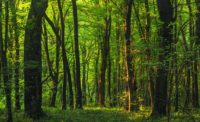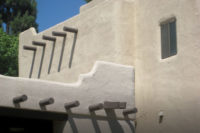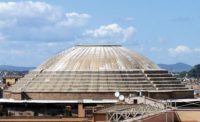
Well it’s about that time of year when those pesky little iron-beaked commanders of the air start wreaking havoc around the neighborhood-in many cases, using your building as their own personal rendezvous point for potential mates. Woodpeckers may be a fascinating visitor to some backyards and birdfeeders but unfortunately we all know how destructive they can be. In fact, for many building owners, a woodpecker is the most damaging wildlife problem they can face, causing thousands of dollars in property damage every year.
Problem
Woodpeckers can’t tell the difference between your exterior cladding and dead trees in the forest so it’s not uncommon for them to cause significant damage to siding, fascia boards, EIFS and especially those beautiful architectural elements created with foam.Most people attribute this damage to woodpeckers looking for food but that is rarely the case. Actually, there are three reasons these birds peck on your walls:
They’re looking for food.
They’re making a nest.
They’re establishing and defining their territory.

A Seattle Retrofit project. This image is a typical hole created in an EIFS cornice from a woodpecker.
The woodpecker will typically drum in one spot for a minute or so, every day. It does not take long before a large, irregular hole appears at the drumming site. If the site is EIFS or EPS, it not only becomes a real eyesore but it can also create problems with system integrity and water penetration. When a woodpecker is looking for grubs, it acts differently and makes a small cone shape or a long gallery of holes. If you ever see a woodpecker searching for insects, it will constantly turn its head as if looking for something on the surface. It is actually listening for grubs feeding in the wall. Then it only makes a hole large enough for its long, thin tongue to catch the bugs.
The holes woodpeckers create searching for food are usually less than 1 inch in diameter. A woodpecker will occasionally attempt to excavate a round nesting hole in the wall but it’s rare and if the wood or surface is solid, they usually give up after a day or two. However, woodpeckers seem to love foam insulation for a nesting site. And what’s worse, even if they peck a small hole and leave, other birds will take advantage of the destroyed lamina and the next thing you know, babies are living in the walls.

This image is an effort to fill a hole with expanding foam.
Government and Remedies
Attempts to discourage the onslaught of woodpeckers are almost humorous: plastic owls, rubber snakes, metal window screen, Mylar strips, unsightly bird netting and even trapping and releasing woodpeckers doesn’t do much good. Unless you release the birds several miles away, they’ll just fly back to their own territory within a day or two.As far as the government is concerned, woodpeckers are classified as migratory, nongame birds and are protected by the Federal Migratory Bird Treaty Act. You can only exercise lethal control or nest destruction with a special permit issued by the Law Enforcement Division of the U.S. Fish and Wildlife Service, upon recommendation of USDA-APHIS-Wildlife Services personnel.
So, a new product was invented to keep woodpeckers away without harming the birds. The product BeakGuard is a patent-pending concept incorporating a blend of ingredients that offer safe and effective protection from woodpeckers. These compounds immediately communicate a warning signal to the birds, prompting them to find a more desirable location. In fact, humans and animals are very sensitive to these compounds. For example, taste-testing has determined that people can detect the ingredients in water at 50 parts per billion.
The product is a breathable elastomeric acrylic finish formulated to apply like standard latex paint. Performance on the other hand far exceeds your typical latex product. The deterrent offers outstanding coating durability, extended service life, provides maximum dirt pick-up resistance and weatherability in a vapor permeable, flexible membrane with exceptional color retention. Although specifically formulated for EIFS and existing acrylic finishes, the product is easily applied to virtually any exterior surface including wood, fiber-cement, stucco, aluminum or vinyl.

Woodpeckers going to town on cedar shakes at a residence in Wisconsin.
Environmentally Safe
BeakGuard will not harm woodpeckers or any other bird species. The ingredients are found in many consumer products on the market today-even nail biting and thumb sucking deterrents for children incorporate this technology. The National Safety Council and American Medical Association recommend similar agents be used, along with other safety measures, in products defined as mild to moderately toxic.After two years of field testing in the most prolific woodpecker areas of the country including Montana, Colorado, South Dakota and Washington, the success rate exceeds 90 percent in deterring further building damage.
All tests were conducted on building structures experiencing ongoing woodpecker damage:
A remodeled office building outside of Seattle with large EIFS cornices was assaulted by woodpeckers every season. In some years, the drumming resulted in more than ten holes around the building. To make matters worse, many of those holes became nesting sites for smaller birds that hatched young inside the walls adding to the damage. Every year the owner paid to have these holes filled with spray foam, sanded, basecoated with mesh and refinished in an attempt to blend the damaged areas with adjacent walls. Year after year.
Two years ago, out of frustration, the owner coated every linear foot of cornice and all other architecture elements on the façade with BeakGuard. Since that day, not a single woodpecker has damaged the building. Not only did BeakGuard enhance the property by creating a bright new look, it appears the problem has been resolved and the birds are off to other locations.
Another client complained a woodpecker was drumming directly outside his bedroom window at 6:00 a.m. sharp every day. Not only a problem because it woke his wife and children every morning-this bird was attacking a fascia board at the apex of the roofline about 27 feet off the ground. Not an area you want to frequent too often.
After renting the extension ladder, BeakGuard was applied directly over the small holes caused by this bird. Not having the highest level of confidence in this miracle product, the client set his alarm for 5:45 a.m. In the dim morning light, he just shook his head as that darn bird landed in the same exact spot as yesterday. The bird cocked his head back and forth a few times, pecked once and flew away. The woodpeckers still frequent his backyard but not a single bird has pecked in the area coated with the deterrent.
Montana-based stucco and EIFS contractor Montana Flexteriors has dealt with the woodpecker issue for years. The 17-year-old business, based out of Great Falls, Mont., began applying the deterrent to an EIFS finish recently and reports good luck.
“If woodpeckers have been hitting a house, they’ll stick around and go at it for a long time,” says Rod Stevens, president and owner. “This product acts as a very good deterrent bond. We’ve done houses that were only finished a day and the woodpeckers would come. They would usually stick around only a 5 foot radius but they can make a mess in a short time frame.”
Stevens says the product has worked very well for his company. The only problem, he says, is if you happen to taste the product.
“The only way to get the taste out of your mouth is Hershey’s chocolate,” Stevens says.
Jim Krock, office manager of Stuc-O-Flex has experience with woodpeckers chipping away at his own house in Washington.
“Every morning about sunrise this woodpecker would peck for a while (at least five minutes or so, or until I ran outside and scared it away) on my bird blocks,” he says. “It didn’t make large holes-it just destroyed the paint and pitted them almost all the way down to the blocks. I painted this stuff on and the woodpecker still comes back to hang out often but I haven’t heard it pecking since the day I put it on. It sure made some strange noises the first day it came back-it tried to peck that day but not more than once or twice, and it hasn’t since.
After repairing the woodpecker damage to their home, another customer was willing to apply the product on two sides of the house only, (of course we promised to coat the other two the following year). As spring arrived, the birds returned as usual and needless to say, the drumming started again. But as the homeowner says, “It’s the most bizarre thing I’ve seen: those darn birds are destroying two sides of my house and won’t touch the others, unbelievable.”
Is BeakGuard the absolute answer to all woodpecker damage in America? Probably not. But if you want to enhance the appearance and extend the service life of your building while drastically reducing the risk of woodpecker damage in an environmentally friendly way, this may be a viable solution.



